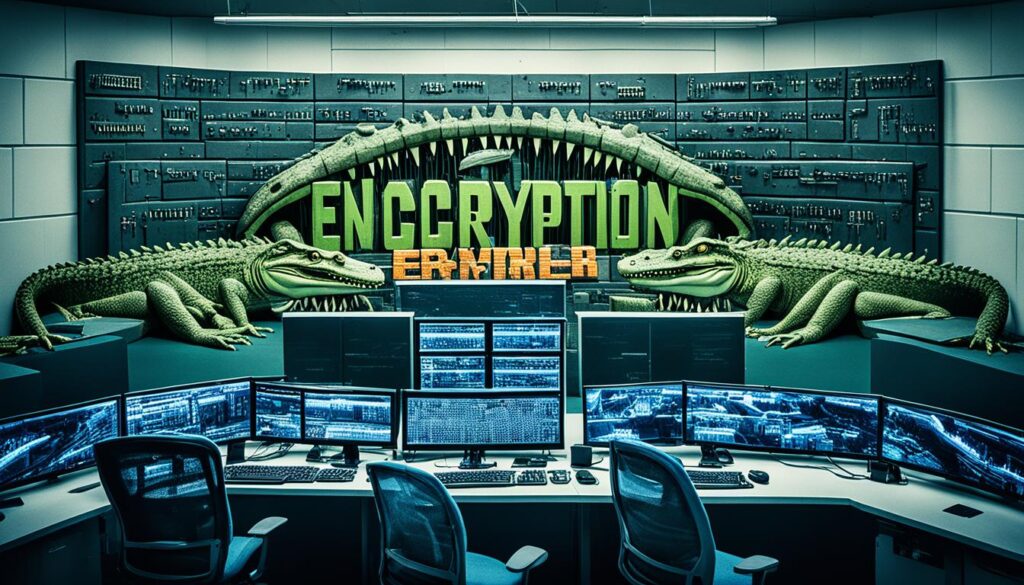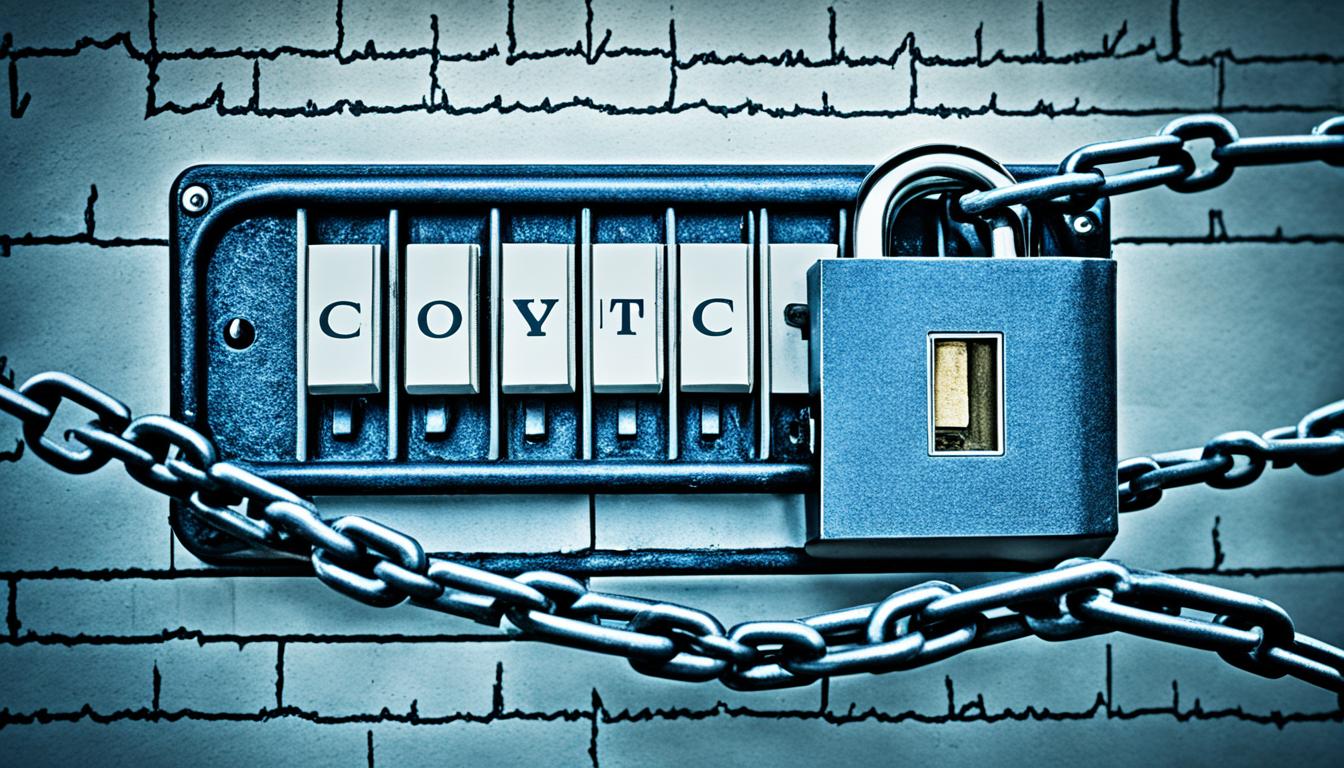Keeping software applications safe is super important today. This is because cyberattacks and other security risks are big threats. Securing these applications helps keep our data safe and protects important systems from harm.
This article will show you why secure software development is crucial. It’ll also offer some tips on how to make software applications more secure. This way, organizations can reduce risks and keep their apps safe from cyber-attacks.
Key Takeaways:
- Secure software development is crucial in today’s digital landscape.
- Implementing best practices ensures the security and integrity of software applications.
- By proactively addressing security concerns, organizations can protect against cyber threats.
- Software application security is essential to protect sensitive data and maintain system integrity.
- Following secure software development practices helps mitigate vulnerabilities and reduce the risk of malicious attacks.
What Happens without Secure Software Development?
Using secure software development methods is key to keeping our apps safe from cyberattacks and bugs. Without them, big parts of our world, like the internet, phone lines, and transport, could face huge problems. These issues could affect daily life for many people.
“The growing number of cyberattacks shows how vital secure software is. It’s not a question of if a group will get attacked, but when.”
– Sarah Thompson, Cybersecurity Expert
In the last few years, cyberattacks have grown more complex and happen more often. This is mostly because hackers are finding and taking advantage of flaws in software. Big attacks like Duqu, Stuxnet, and WannaCry show just how much damage these vulnerabilities can cause.
Critical systems, like those in our phones and cars, are especially at risk. If the software in these systems is not secure, it could allow bad actors to do a lot of harm. They might disrupt services, steal important data, or even put people in danger physically.
Here are some key points about past cyberattacks to show you how serious they can be:
| Cyberattack | Implications |
|---|---|
| Duqu | Stole sensitive data and allowed unauthorized remote access to infected systems. |
| Stuxnet | Compromised industrial control systems, targeting Iran’s nuclear program. |
| WannaCry | Infected hundreds of thousands of computers worldwide, causing widespread disruption and financial losses. |
These examples clearly show why we need to focus on secure software. Using secure development methods can help prevent these kinds of attacks. It makes our software safer and more reliable for everyone.
The Risks of Insecure Software Development
Not using secure software methods can lead to many problems for businesses:
- Cyberattacks: Weak software can give hackers a way in, leading to stolen data or financial losses.
- Software Vulnerabilities: Lack of proper security can create openings for attackers to disrupt systems or gain unauthorized access.
- Reputation Damage: A successful attack can hurt how people see a company, losing trust from customers and others.
- Loss of Confidentiality: Bad software can accidentally share private information, hurting the trust between a company and its customers.
- Legal and Compliance Issues: Not following security laws can lead to fines and legal trouble.
5 Key Software Security Development Risk Factors
Secure software development faces many important risk factors. These can lower the safety of software and raise the chance of flaws. It’s key to know and reduce these risks to keep software safe and sound.
1. Interdependent Systems
Interdependent systems are a major concern for software security. Connections between parts in big software setups are often the weakest areas in security. If one part is compromised, others can also be at risk, encouraging more complex attacks.
2. Software Size and Complexity
The size and complexity of software pose challenges in finding and fixing security flaws. Large projects have a lot of code and complex designs, making full testing hard. This complexity can hide vulnerabilities, making the software an easy target for attacks.
3. Outsourced Software Supply Chain
Outsourced software is common in our global world, but it brings in new risks. Using outside help means more eyes are on your project. Monitoring these partners closely is essential to prevent vulnerabilities in your software.
4. Sophisticated Attacks
The threat of cyberattacks is always changing, with attackers using new, complex methods. To stay safe, software developers must keep up with the latest in security. This includes monitoring tech trends and protecting software against new threats.
5. Legacy Software
Old software is risky due to its outdated security measures. It often doesn’t get the updates it needs to protect against current threats. Without proper checks and updates, older software could leave systems wide open to attack.
To make software development more secure, it’s vital to tackle these risks. Putting strong security methods in place and keeping up with new threats are essential steps. This ensures software stays safe and reliable.

Common Secure Software Engineering Issues in Today’s Application Security (AppSec) Landscape
In the world of app safety, developers often meet challenges. These can make apps less safe. Common issues include:
Vulnerabilities in Third-Party Libraries and Frameworks
Developers use outside libraries and frameworks a lot. But, these can bring in new risks. Regularly updating and checking for problems is key.
Injection Attacks
Injecting bad code into an app is a big issue. There are SQL and code injection types. Stopping these starts with checking the data users put in the app.
Cross-Site Scripting (XSS)
XSS attacks sneak in bad scripts. This can lead to theft or unauthorized use. Good input checking and coding help stop these.
Insecure Authentication and Authorization Mechanisms
Bad login practices can let attackers in. Strong logins and checks, like using more than one step, help keep apps safe.
Insufficient Logging and Monitoring
Not tracking what happens and missing alerts can be disastrous. Logging everything and watching security in real-time is critical.
Mobile Application Security Vulnerabilities
Mobile apps have their own set of risks. Making sure the data is safe and not easily seen is crucial.
Cloud Security Risks
The cloud brings special dangers too. By controlling who gets in and watching closely, many problems can be avoided.
To deal with these issues, security must start from day one of making an app. Keeping up with safety tips and doing regular checks make apps stronger and safer.
How Do SAST Tools Help Ensure Best Practices for Secure Development and Secure Software Engineering?
SAST tools are crucial for secure software development. They help prevent vulnerabilities and security issues early. A leading tool, Klocwork, scans the code to find potential problems. This proactive approach improves software security.
These tools let developers spot security problems early in the coding phase. They don’t have to wait until testing after the code is complete. By checking the code thoroughly, vulnerabilities and bad coding habits are found. This makes the software safer right from the beginning.
Using SAST tools makes the whole development process safer and smoother. They give clear advice to developers, pointing out key issues. Armed with this data, developers can enhance security and fix any mistakes.
SAST tools are more thorough than conventional testing. They look deeply into the code’s security. This ensures projects meet high safety standards. They help avoid common security pitfalls, like attacks and poor login systems.
“SAST tools offer a proactive approach to software security, enabling early vulnerability fixes.”
Benefits of SAST Tools in Secure Development:
- Early detection of security vulnerabilities and weaknesses
- Proactive implementation of secure coding practices
- Enhanced code quality and reliability
- Increased developer productivity by identifying security issues early
- Cost-effective security measures by avoiding post-development fixes
Integrating SAST tools into development enforces best security practices. Developers get instant feedback on security flaws and fix them fast. The software becomes more secure against attacks.
Remember, SAST tools work best with other security methods. Teams should also use penetration testing and follow security guidelines like OWASP Top 10. This layered approach offers the best defense against cyber threats.
Using SAST tools is a key step in building strong security for software. They allow for early detection and fixing of vulnerabilities. This cuts down the chances of breaches and ensures secure software is developed.

| SAST Tools in Secure Development | Benefits |
|---|---|
| Early detection of security vulnerabilities | Enables proactive security measures |
| Identification of insecure coding practices | Enhances code quality and reliability |
| Real-time feedback for developers | Increases developer productivity |
| Cost-effective security measures | Avoids post-development fixes |
Why Is Security in Software Development Difficult?
Creating secure software faces many hurdles. Developers deal with several issues when trying to make their applications safe.
Software Development Priorities
In software making, getting to the market quickly often wins over other needs. Vital security steps can get overlooked to meet deadlines and hit business goals.
Software Quality vs Security
Developers frequently battle choosing between software that’s top-quality and very safe. Finding the right mix to keep software strong and safe, yet useful, is hard.
Complexity of Embedded Systems
Systems embedded in various products, like health devices or IoT gadgets, make security even tougher. They are complex, needing experts’ focus to guard every part well.
Lack of Secure Software Training
Not all developers get enough training in making software secure. Some might not fully know how to spot and fix security risks, slowing down safe program creation.
Lack of Ownership of Security
In some teams, no one fully owns making software secure. Without clear responsibility, security often gets neglected. This makes software an easy target for cyberattacks.
Solving these issues is key to making sure software is secure and works well.
10 Best Practices for Secure Software Development
Developing secure software means using the right practices to reduce risks and protect against cyber threats. These ten practices make sure your apps are safe and reliable.
- Threat Modeling: Start by finding and understanding the threats and weak points in your app. Knowing these risks helps to add the right security measures.
- Secure Software Coding: Use secure coding methods like checking input and keeping data safe. These practices stop common security problems such as injection attacks.
- Code Review: Always check your code for security issues. Doing this catches problems early on, making it harder for attackers to use them.
- Testing: Have a thorough testing plan, including trying to break into your app and scanning for weak spots. Testing often finds and fixes problems before they’re big issues.
- Secure Development Frameworks: Use trusted frameworks for secure software like the OWASP Top 10. These guides help set up a strong and safe app.
- Authentication and Authorization: Make sure only the right people can use your app and see its data. Good security here stops unauthorized access.
- Data Encryption: Keep important data safe with encryption. Even if attackers get it, they won’t be able to read it without the right key.
- Secure Third-Party Libraries: Be careful with libraries and tools from others. Make sure they’re safe and get updated to fix known problems.
- Secure Configuration Management: Control how your app is set up tightly. This stops unauthorized use and makes it harder for attackers to find a way in.
- User Education: Teach your users how to use your app safely and understand security risks. This makes it less likely for mistakes to cause problems.
Following these ten steps will make your software much safer and protect it from cyber threats.

Protect Your Database From SQL Injection
SQL injection is a serious threat to web apps. It happens when hackers put SQL code into places where users can input text. This tricks the app into doing things it shouldn’t. To keep your database safe, use techniques like parameterized queries.
Parameterized queries keep SQL code separate from user data. This stops the leaked SQL code from running as commands. Instead of mixing user input with SQL, you use placeholders. This way, the database understands what’s safe data and what’s a command.
But that’s not all. Many secure coding methods help fight SQL injection. One key method is input validation. It checks and cleans the user’s input, only letting in safe data. Doing this early in the code can stop a lot of attacks.
Another key step is keeping your data safe. Encrypt important data and control who can access it. This helps a lot in preventing or lessening damage from an attack.
Secure coding isn’t just about SQL injection. It’s critical for all apps to be strong against different attacks. This makes sure your data is always secure.
Benefits of Using Parameterized Queries and Secure Coding Practices
- Prevent SQL injection attacks by separating code from data
- Reduce the risk of unauthorized access to sensitive information
- Mitigate the potential damage caused by data breaches
- Enhance the overall security of your software application
Using parameterized queries and secure coding greatly boosts your database’s security. This not only protects your organization but also your users’ data.
| SQL Injection Risk | Prevention Measures |
|---|---|
| Input validation | Implement input validation routines to filter and sanitize user input |
| Parameterized queries | Use parameterized queries to separate code from data |
| Secure data storage | Encrypt sensitive data and enforce proper access controls |
Encode Data Before Using It
SQL injection isn’t the only risk for software. There are many kinds of injection attacks. These include LDAP, XML, XPath, OS Command, and JavaScript (XSS) injections.
To keep software safe, it’s key to encode and escape data first. This prevents code execution without permission.
When we encode data, we turn it into a form where it can’t be mistaken for code. Escaping involves adding special characters to stop code misinterpretation.
Doing this stops most injection attacks. It makes sure the code does what it’s supposed to. This stops bad code from being added and running. Proper handling of data is crucial for software’s safety.
Data Encoding and Escaping Techniques
Depending on the programming used, data encoding and escaping have different methods. Here are a few ways:
- HTML Entity Encoding: Changes special characters to hide their code meaning. For instance,
- URL Encoding: Makes special characters safe for URLs. A space turns into %20, and & turns into %26.
- JavaScript String Escaping: Protects special characters in JavaScript with a backslash. For instance, ” becomes \”, and a new line becomes \\n.
- Query Parameter Encoding: Makes query parameters safe from SQL attacks. It employs techniques like parameterized queries and stored procedures.
Adding these steps during development boosts application security. It makes it harder for attackers to inject harmful code.
Validate Input Data Before You Use It or Store It
It’s a big deal to validate input data for software security. When you check data well, you make your programs safer. This stops many common bad tricks and attacks.
Doing checks on the server is a smart way. It makes sure data is good and safe before using it a lot. This is much better than only checking on someone’s device, where bad people can find a way in.
Using lists of okay things to look out for is also very wise. It lets your program say no to things that don’t look right. This is key in stopping some of the worst attacks.
Tools like fuzzers and analysis helpers make validation easier. Fuzzers try out weird data to see how your program reacts. Analysis tools find weak points by studying how data spreads in your program.
Data validation is key for software safety. Doing good server-side checks and using safe input tools makes your app stronger against harm.
In the end, secure software needs careful validation. By checking data on the server, using whitelist methods, and good tools, you cut down on risks. This way, you keep your software safe.
| Input Validation Best Practices | Benefits |
|---|---|
| Implement server-side checking | Prevents bypassing client-side checks |
| Use positive whitelist validation | Mitigates risks of injection attacks |
| Employ input validation tools | Enhances accuracy and efficiency |
Next Steps
Now you see why data validation is so vital. Think about using these steps in your software building. Keep learning about security and new tools.
Access Control—Deny by Default
Using strong access control is key for safe software development. It employs the rule “deny by default”. This means the software checks if users are allowed before giving access. It makes sure only the okayed users can get into the system’s secret parts.
Role-based access control (RBAC) is known to work well. It sorts users into roles and hands them the right permissions. This way, you can control who sees what, making sure everyone only gets in where they should.
For better access control, many companies turn to tools like Apache Shiro. These tools have everything needed to manage who gets into the software. Using them makes it much simpler to make an application secure.

Securing access is vital for keeping sensitive info safe and stopping the wrong people from acting harmfully. With the “deny by default” rule and tools like RBAC and Apache Shiro, developers can better protect their software. They can keep the most important parts off-limits to anyone but the right people.
Conclusion
Today, making software safe is very important. It is key for companies to focus on security all the time. This way, they can stop bugs and avoid cyber attacks. By using the right methods and sticking to a security plan, they will make safe software and keep their programs safe.
The NIST Secure Software Development Framework is a great help for companies. It lays out everything they need to do to make their software safe. This includes how to build, test, and use the software safely. By using this guide, companies will make their software safer and start from a secure base.
It’s very important for companies to follow good security practices. This means thinking about possible threats from the start. Companies should also write code in a safe way and check it often. They should test their software well and use special security tools. All these actions help make sure the software is safe at every step, making bugs and attacks less likely.
FAQ
What is secure software development?
Secure software development means adding safety measures from the start to the finish of creating software. This is to keep the software safe from online risks and flaws.
Why is secure software development important?
It’s key to reduce dangers from cyberattacks and flaws in software. Adhering to secure procedures helps keep apps safe and protects important information.
What are the risks of insecure software development?
Not focusing on security can result in cyberattacks, flaws, and breaches of important data. It could also affect major services like power, telecoms, and transport.
What are the key risk factors in software security development?
The main risks in this area include linked systems and private suppliers, big and complex software, new kinds of cyberattacks, and using older software again.
What are common secure software engineering issues in today’s application security landscape?
Issues include risks in libraries and frameworks, attacks like injections and XSS, weak login systems, and not enough monitoring. Also, issues in mobile apps and using cloud services bring risks.
How do SAST tools help ensure best practices for secure development and secure software engineering?
Tools like Klocwork help by checking software code for security issues. They do this without running the code, allowing for early security fixes and better software safety.
Why is security in software development difficult?
It’s hard because often speed and features are put above security. The process is made harder by complex systems and a lack of security training among developers.
What are the best practices for secure software development?
Practices include looking carefully at threats, secure coding, checking code often for security issues, and testing thoroughly. Following known security guidelines is also important, like OWASP and NIST.
How can I protect my database from SQL injection?
To stop SQL injection, use parameterized queries. These keep data and commands separate so that the database knows what’s safe to execute. Always validate input to stop injection attacks.
How can I encode data before using it to prevent injection attacks?
To prevent attacks, encode data before sending it to external systems, like databases or web pages. This stops code from running by accident and keeps your systems safe.
Why is validating input data important for secure software development?
Checking input is crucial to keep software safe. Server-side checks are better than client-side only. They stop common attacks and lower security risks.
How can I implement access control measures for secure software development?
Secure software needs strong access controls. Always check who uses what. By default, block access and only let authorized users in. Tools like Apache Shiro make this easier.
How can organizations prioritize secure software development?
By making a strong security policy and sticking to trusted approaches like NIST, companies can focus on software security. This keeps software safe from threats.


















